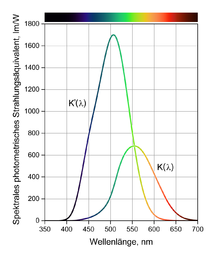Candela
![]()
The title of this article is ambiguous. For other meanings, see Candela (disambiguation).
The candela (Latin for 'candle', emphasis on the second syllable: [kanˈdeːla]) is the SI unit of the SI base quantity "luminous intensity".
The luminous intensity in a certain direction is the quotient of the luminous flux emitted by the light source in this direction (unit lumen, lm) and the solid angle shone through. A light source that 

The value of the unit was chosen so that a household candle has a luminous intensity of about . 
Definition
connection to tidal flats
The candela is defined by the fact that for light of a certain frequency, the radiant intensity (measured in watts per steradian) is converted by a fixed factor into the luminous intensity (measured in candela = lumen per steradian). The candela is thereby linked to the SI unit watt. The definition is:
"The candela, unit symbol cd, is the SI unit of luminous intensity in a given direction. It is defined by fixing for the photometric radiation equivalent Kcd of monochromatic radiation of frequency 540-1012 Hz the numerical value 683, expressed in the unit lm W-1, which is equal to cd sr W-1 or cd sr kg-1 m-2 s3, the kilogram, the metre and the second being defined by means of h, c and ΔνCs."
This corresponds to the formula:

This definition was adopted in 1979 and has remained unchanged since then. Only the wording was adapted in 2019 as part of the revision of the International System of Units. The mentioned frequency of 540 THz corresponds to green light with a wavelength of ≈ 555 nm.
Photometric background
Light is electromagnetic radiation that can be perceived by the eye. However, the eye has different sensitivities to different wavelengths. To determine the light stimulus exerted on the eye by a given radiation, the radiant power must be multiplied by a wavelength-dependent conversion factor for each wavelength of the wavelength mixture present. In this way, the radiometric quantity "radiant power", measured in watts, gives the corresponding photometric quantity "luminous flux", measured in lumens. A radiant intensity measured in watts by steradians corresponds to a luminous intensity measured in lumens by steradians, i.e. candela. The course of the curve of the spectral perception ability of the human eye required for the conversion is fixed by standardization. The definition of the candela determines the scale factor for this curve by specifying the above-mentioned numerical value for a point on the curve.
Choice of wavelength
The definition specifies the frequency of the reference radiation, not its wavelength. In this way, it is unnecessary to specify a refractive index for the surrounding medium.
In air under normal conditions, the wavelength 555 nm (green light) corresponds to the mentioned frequency of 540-1012 Hertz. At this wavelength, the human eye has the highest sensitivity during daytime vision. Coincidentally, the sensitivity curves of the eye for day and night vision, K(λ) and K′(λ), intersect in the immediate vicinity of this wavelength (namely at approximately 555.80 nm). According to SI and DIN, the definition is therefore valid for day vision as well as for twilight and night vision.

Spectral photometric radiation equivalent for day vision K(λ) and for night vision K′(λ).
History
Originally, units of measurement for luminous intensity were defined using standardized reference light sources, such as the Hefner candle. With their flames, a light source to be measured could be compared as brighter or less bright.
After the advisory committee for photometry had already passed a resolution to this effect in 1937, the candela was introduced in 1946 (before ratification by the CGPM in 1948 it was still referred to as the "new candle") and was defined as follows until 1979 (official German translation of the wording valid from 1967):
"The base unit, 1 candela, is the luminous intensity with which 1/600 000 square meter of the surface of a black body radiator shines perpendicular to its surface at the temperature of platinum solidifying at pressure 101 325 newtons per square meter."
This definition established a relation between the radiometric radiance and the corresponding photometric luminous intensity of a blackbody radiator at a temperature 2045 K. At this temperature, the spectral radiance has its maximum at λ ≈ 1.4 µm, i.e. in the near infrared.
The experimental realization of this definition could only be achieved with great effort. It required platinum which had a high purity and retained it during the measurement, uniformly equal temperature, exact measurement of solid angle and influence of lens optics as well as exact consideration of absorption by air and steam. Only a few laboratories had appropriate measuring apparatus, and the results were only about 1% reproducible. An improvement of this situation was not to be expected. Radiometric measurements, i.e. direct measurements of radiation power, on the other hand, could be carried out more and more accurately. Therefore, the new definition was made in 1979.
By the choice of the mentioned frequency and the numerical value 683 lm/W for the photometric radiation equivalent at this frequency, the new definition of 1979 directly follows the previous definition. However, it is now no longer dependent on the difficult realization of a blackbody radiator at a high temperature. Moreover, by restricting it to monochromatic radiation, it takes into account the modern possibilities for measuring optical radiant power and also returns the measurement task to the much more fundamental case of monochromatic radiation. The new definition is also more general: it now allows, for example, the sensitivity curves of the eye to be measured directly, whereas previously they were implicitly part of the definition in their entirety. The previous definition provided an exact photometric value only for a special case with a complex broadband wavelength distribution.

Cavity radiator for the realization of the candela until 1979 (schematic). (1) Tube of refractory thorium oxide as cavity radiator; (2) Container of thorium oxide; (3) Solidifying platinum as temperature reference.
Search within the encyclopedia
